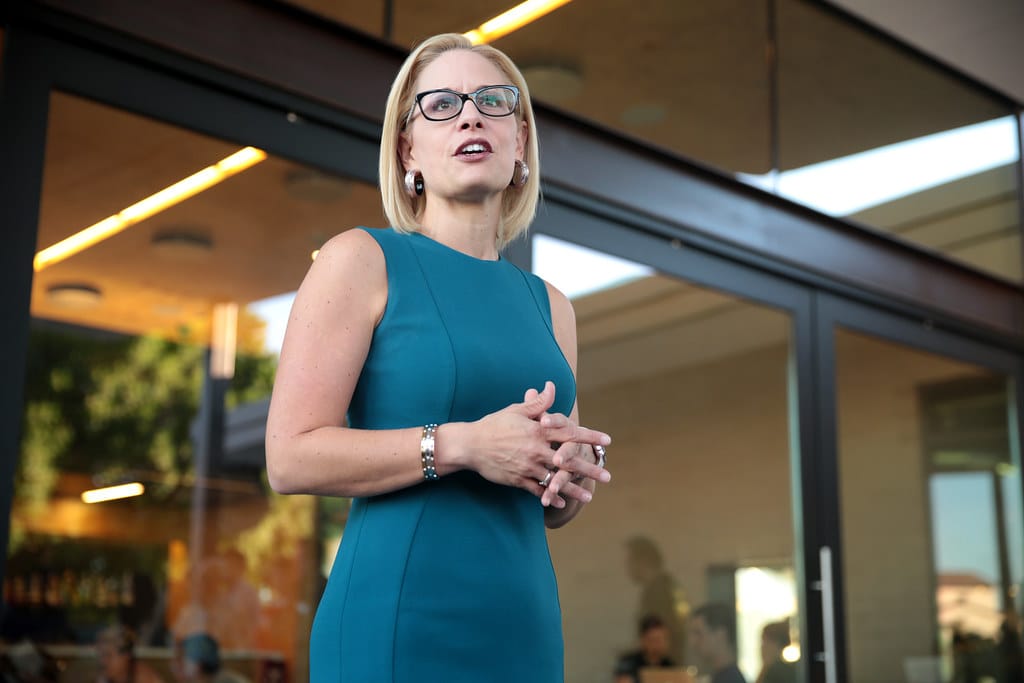Sinema Policy Advisor Says Infrastructure Bill’s Broadband Promise Balances Partisan Interests
And experts weigh in on the benefits of crowdsourcing data for better broadband maps.
Justin Perkins

WASHINGTON, October 27, 2021 — Ahead of a Halloween deadline for the House to vote on the infrastructure bill, the policy staff person of Senator Kyrsten Sinema, D-Arizona, said he thinks the infrastructure bill’s broadband provisions balance competing interests between progressive and moderate Democrats, who disagree on the bill’s details.
“I think it’s a strong bill,” said Sinema’s policy advisor Chris Leuchten. Leucheten, who spoke in his personal capacity at a broadband infrastructure panel with the Federal Communications Bar Association on October 13, avoided saying whether Sinema would approve of the bill but said “balancing competing interests is important.”
Leucheten added that Arizona has 22 federally recognized tribes and that expanding broadband has been difficult for the state due to a lack of funding. Focusing on ensuring funding for tribal lands in Arizona “is a key piece for us,” Leuchten said. The bill includes $65 billion for broadband.
The House is expected to vote on the bipartisan bill on October 31, 2021.
Bipartisanship led to passage in the Senate
Tech advocates are eager for the broadband infrastructure bill to pass the House. Leuchten said he wants a positive outcome after his team’s hard work to build relationships in the Senate to get enough votes. “It took months on multiple levels of [Senate] staff to get it done in order to reach a bipartisan agreement here and have some honest discussions to put together a framework to the bill.”
Alexandrine de Bianchi, senior legislative assistant to Sen. Jacky Rosen, D-Nevada, said that her working bipartisan group “worked off a few bills to provide a foundation for the broadband section of the bill.” Previous broadband bills were “cobbled together” in order to get to finalized bill.
FCC should crowdsource data for better broadband maps
Panelists also discussed broadband mapping as a fundamental challenge to allocating the bill’s funding and suggested crowdsourced mapping to gather more data. “[The] maps are foundational to everything we have to do,” said Trey Hanbury, partner at Hogan Lovells. “The job is to direct funding to where it is needed.”
FCC Acting Chairwoman Jessica Rosenworcel said during a symposium Friday that she is optimistic about the agency’s latest efforts at mapping and said crowdsourcing methods have proven to be highly effective.
The idea of crowdsourcing broadband coverage data reflects a shift in the broadband mapping philosophy by moving away from the FCC’s historical data collection methods.
“The FCC form 477 established in 2000 was the traditional way to collect mapping data,” said Kirk Burgee, chief of staff for the Wireline Competition Bureau. “[But we] had no view into what was happening on the census block level. To address the shortcomings in form 477, the 2020 Broadband Data Act created requirements for data collection that would address problems with the old form,” referring to the challenge process that allows others to challenge the FCC’s own information.
Advocates for crowdsourced broadband mapping believe that the public can make the FCC’s maps more accurate. Bryan Darr, vice president of smart communities at Ookla, said that the benefits of this method make crowdsourcing a long-term solution to mapping issues.
According to Darr, the volume of data captured is “exponential” relative to other efforts. He said there will be fewer spikes and troughs in data collection because of a loyal user base. The diversity of the users would “capture the many ways people use the internet” Darr said.
Additionally, years of data will allow for greater measuring of progress over time and strengthen the credibility of coverage targets. Combining the source of the data gives stakeholders a better idea of the digital divide than individual data sets themselves, said Jennifer Alvarez, CEO of Aurora Insight.
“The public needs to have a say [in mapping broadband]. Using these capabilities allowing people to report needs to be taken into account and part of what should be understood about broadband mapping. We’ve got to do it quicker than we have been doing it historically” said Darr.
Broadband experts agree that compiling and aggregating mapping data will produce a better picture of underserved and unserved communities.










Member discussion